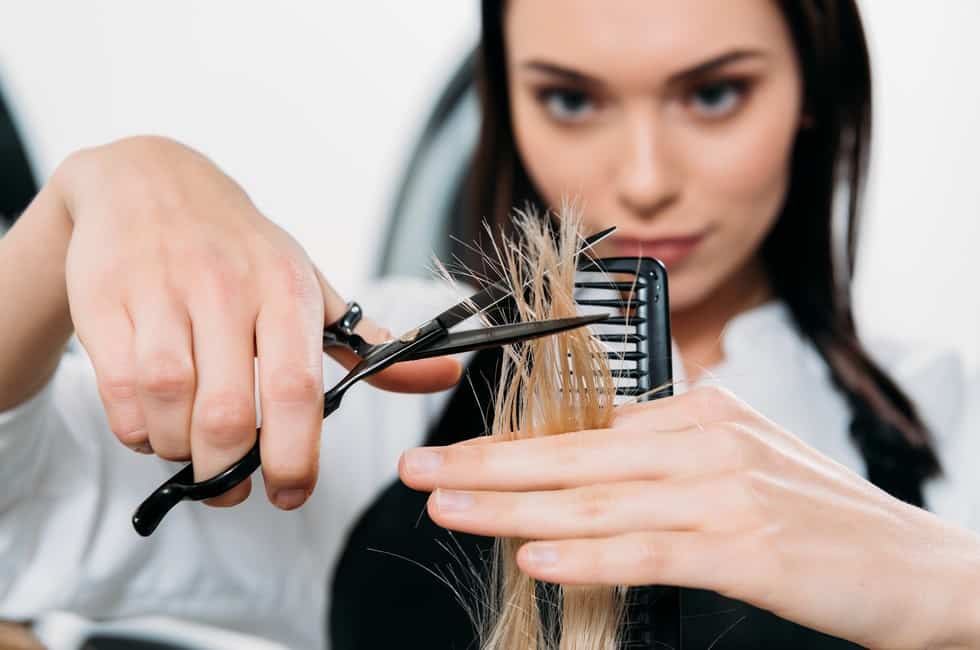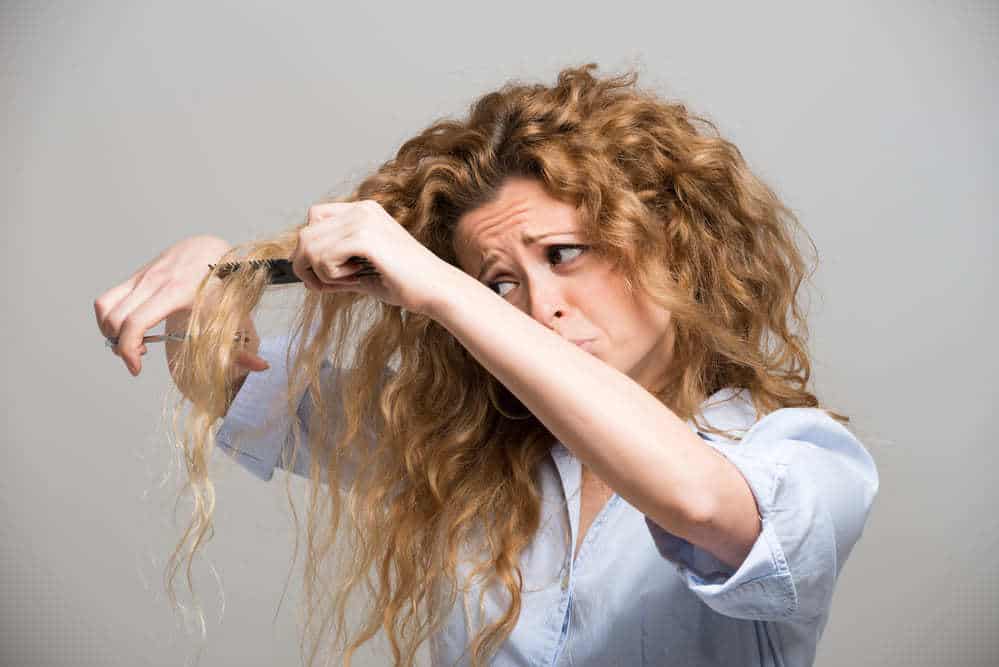When the protective layer of your hair is damaged, split ends occur. Unfortunately, dealing with them is the most challenging part of any hair care routine.
Whether you have straight or curly hair, not cutting your split ends has consequences. Therefore, we rounded up some tips on treating and preventing them.
Generally, split ends can make hair look dull, tangled, and generally more sad-looking. When left untreated, they can even travel up the hair shaft, causing the hair to break off higher.
Those who are preserving their length tend to skip on trims. However, greater damage could even lead to shorter haircuts.
Can Split Ends Heal Without Cutting?
No. Those split ends are irreversible damage, and no amount of hair products could fully repair them.
In fact, split ends aren’t just strands of hair that split in two, but they actually look similar to an unraveled rope, or a piece of fractured wood with many edges and jagged ridges.
Do You Really Need to Cut Split Ends?
Yes. Cutting them is the only fix to mend the strands. Even if you treat them with conditioner, oils, and hair serums, they won’t ever go back to healthy, virgin hair if you don’t cut them.
Split ends stand in the way of great-looking hair, so there’s no need to preserve them if you’re just retaining your length.
Will Your Hair Still Grow if You Have Split Ends?
Of course! Split ends will never stop your hair from growing longer, and they won’t affect your hair growth cycle. If you don’t have any medical condition that causes you to lose hair, it’ll continue to grow.
Unfortunately, split ends can cause your hair to break off, so you’re somehow losing length. Still, it’s better to trim your ends sooner than later, so you’ll be able to cut them before they split.
What Would be the Consequences of Not Cutting Your Split Ends?
Apart from dull, dry hair, split ends may cause more breakage when left untreated. In fact, they’re notorious for causing your strands to break off and split faster as if your hair isn’t growing at all.
The damage starts at the ends of your hair. However, it’ll eventually travel up your hair and break higher. You might think that not cutting your hair will preserve the length, but you’re actually risking it.
Those fragile ends can leave your strands shorter than before, especially if there’s significant damage. By cutting those unwanted split ends, you’re giving your hair a new clean slate to start again.
How Do I Stop Getting Split Ends?
Apart from deep conditioning treatments, getting regular trims is a must. You don’t have to go for a drastic or shorter haircut.
You only need to get ahead of those split ends. Some even opt for hair products that smooth the hair down and make that split ends look healthy, but it’s just a temporary fix.
Tips on Treating and Preventing Split Ends

It’s quite challenging to prevent split ends, but there are lots of things you can do to reduce their severity. As with any hair damage, prevention is key. And the real secret to good-looking hair is healthy hair.
Deep condition your hair twice to thrice a week
Apart from strengthening shampoos and conditioners, opt for products formulated with natural oils like coconut and argan. Level up your hair care routine with a hair mask that smoothens the cuticle while nourishing your strands.
Opt for products that not only make your split ends less noticeable but also work on a molecular level to treat your strands.
Lessen friction and hair manipulation
Split ends can be aggravated with friction, especially if your strands are dry. Think of investing in silk hair scarves or silk pillowcases to lessen friction while you sleep.
Also, it’s better to comb in the shower with the conditioner on. Also, pat dries your hair instead of towel drying. Keep in mind that certain hairstyles can cause split ends such as ponytails and hair twists, so be gentle with your hair.
Avoid heat styling your hair, but use a heat protectant if you have to
Heat styling is one of the causes of split ends. So, it’s recommended to go for hairstyles that won’t need those blow dryers, flat irons, and curling irons.
If you can’t completely avoid them, opt for a heat protectant that takes advantage of heat to treat your ends. It can do double duty on serving as a barrier from heat while nourishing your strands.
Also, avoid hitting your hair with heat when it’s still soaking wet, as it will only fry your strands. Extreme weather conditions can affect your hair too. So, apply a UV protectant when going outdoors.
Get regular trims and haircuts
As we have seen, regular trims aren’t optional. You shouldn’t wait for split ends to appear before trimming your ends. Also, you might want to avoid hair services that damage your hair even more such as straightening and coloring.
How to Know When It’s Time to Trim Your Hair?

A “regular” trim can mean different to different hair types and textures. Here’s how often should you cut if you have fine, wavy, curly, or oily hair.
Thin, fine hair
Split ends are very noticeable on finer textures and tend to make your strands frizzy. Hair professionals recommended getting your ends trimmed every 5 weeks.
Also, opt for gentle hairstyles that won’t need extreme manipulation of your hair. You might also want to avoid too tight ponytails that pull the hair.
Wavy hair
Wavy hair is less fragile than fine hair, so you can trim your hair every 6 weeks to avoid split ends. Since your hair already got that bounce and volume, you may skip those heat styling tools.
Curly hair
Curly hair is tricky to manage as it tends to tangle and knot into each other. Unfortunately, constantly combing them will lead to more split ends and damage. It’s safe to trim your ends every 8 weeks, but you can also have them cut earlier, especially if uncontrollable frizz is also an issue.
Oily and kinky hair
These hair types tend to get dry ends due to the natural oil from the scalp hardly gets to the ends of the hair, resulting in split ends. A great thing, most individuals with oily and kinky hair follow a strict hair care regimen. So, trimming the ends for 9 to 12 weeks can be ideal.
Related Questions
When you should trim your color-treated hair to avoid split ends?
Regardless of your texture, color-treated hair is more prone to damage than natural hair.
If you often opt for straightening and highlight procedures, it’s recommended to get a trim with every treatment. This way, you’ll keep your hair healthy and prevent split ends.
Will you still get split ends when you’re having a good hair care routine?
Regardless of your hair type, texture or color, split ends can happen. You may even get some strands with multiple slits on them. You must know that some hair types can be affected by split ends more than others especially ones with fine, thin hair, as well as kinky hair.
When your hair is exposed to chemical processing, heat styling, and harsh products, your ends will eventually break. Those factors leave your hair vulnerable to breakage and splitting but unhealthy habits, practices, and hairstyles can damage your hair to the point of splitting.

